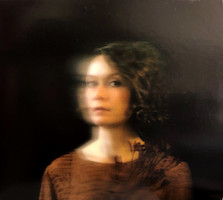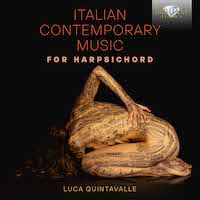Pièces de Clavecin 14. / Italian Vacation 16.
|
Grant Chu Covell [June 2022.]
“Frammenti del discorso amoroso.” Giovanni PICCHI: Toccata (1619); Pass’ e mezzo (1619). Tarquinio MERULA: Toccata del secondo tono (ca. 1620-52); Capriccio cromatico (ca. 1620-52). Girolamo FRESCOBALDI: Toccate e partite d’intavolatura, Book 1: Cento partite sopra passacaglia, F. 2.29, and Toccata duodecima, F. 2.12 (1637). Bernardo STORACE: Ballo della battaglia (1664); Ciaccona (1664). Michelangelo ROSSI: Toccata settima (ca. 1657). Gregorio STROZZI: Capricci da sonare cembali et organi: Toccata de Passacagli, e ciascheduno può sonarsi à solo (1687) and Toccata prima per cembali et organi, con pedarole e senza (1687; arr. Marianna HENRIKSSON and Tuomas NORVIO). Marianna Henriksson (hpsi). Siba Records SRCD1020 (1 CD) (www.siba.fi). This is not new (released in 2018), but it is one of those rare productions which are so good that I do not want to write about it, because words necessitate arriving at complete thoughts and feelings. Over the last few years, I have selfishly enjoyed this vibrant disc, and have wanted to enjoy it without trying to pin down the words. (Also, Walt had brought this program and its performer to my attention, and that’s another reason I’ve been slow to act: There’s but a finite number of Walt’s recommendations for me to explore.) In performances of Baroque harpsichord music we expect a degree of fluid tempos, generally subtle but most always contributing to expression. Skillful players must look beyond the barlines and see the larger shapes and rhythmic patterns. Henriksson is such a soaring player, and Frammenti del discorso amoroso is especially, practically perfectly, rich with fluid tempos and expression. One may argue that such elasticity is uncustomary in performances of the early Baroque, indeed other performances of some of these pieces (e.g.: Picchi’s Toccata, Merula’s Capriccio cromatico) are generally stiffer, as if players were also required to simulate centuries of stale dust. Most of these pieces are toccatas which pre-Bach consisted predominantly of passages involving rapid notes delivered over a steady repeating harmonic sequence. While notated, these early 17th-century pieces suggest improvisations gradually becoming more complex and ornate. There may be imitation (one voice repeating another), but rarely fugal counterpoint as we expect with Bach. Henriksson finds the ideal balance between strictness and improvisation, playing clearly and conveying a continual sense of discovery. Another unifying thread is indicated with the program’s title: “Frammenti del discorso amoroso” which points to Fragments d’un discours amoureux, Roland Barthes’ 1977 book (A Lover’s Discourse: Fragments). Henriksson relates how the emergence of monody, or a single line, in Renaissance Florence as the 16th century folded into the 17th, could effectively and sincerely convey emotions. Her program illustrates “…the same ideals of monodic expression of contrasting emotions, albeit without lyrics. It is speech without words, emotional recitative on the keyboard.” We are to consider these toccatas and dances as love letters, first person articulations of “longing, crying, laughing, blackmailing, losing temper, falling into exhaustion, resigning.” Not everyone will pick-up on this recital’s amorousness. Henriksson’s perspective does imbue these pieces with flavor and passion, but nothing more excessive than what we should ascribe to a first-rate performer. The few Barthes quotes (in English) in the booklet confuse rather than help because Henriksson anchors her concept in the 17th century without needing Barthes’ assistance. The music speaks for itself. Rather, Henriksson has found her own unambiguous route through these pieces. The last track may startle. With help from sound engineer Tuomas Norvio, Strozzi’s pedal points are set in motion with reverberant electronics. The harpsichord becomes cocooned in a thickening echo suggesting an organ but aligned to Strozzi’s harmonies. Is it meant to suggest something psychedelic from a few decades before? At the very least we are clearly no longer in the 17th century. Indeed we are reminded that while Henriksson anchors her perspective in 17th-century aesthetics her approach is modern. As mentioned before, most other recorded performances are far less supple. Henriksson’s Frescobaldi is on par with Rousset’s, though Henriksson’s instrument and recording is more vital. Jean Rondeau’s fine recital Melancholy Grace (Erato 0190295008994) overlaps somewhat (including works by Frescobaldi, Picchi, Storace and Strozzi), but Rondeau’s softer recording takes a slightly aloof, dreamy approach contrasting Henriksson’s directness. Rondeau concludes with one of Dowland’s Lachrimae (No. 7) which had inspired his program and mood. Recorded at Kallio-Kuninkala, Järvenpää, Finland, July 2017, on an Italian harpsichord after Mucciardi built by Andrea di Maio in 2010.
“Italian Contemporary Music for Harpsichord.” Francesco FILIDEI: Preludio e Filastrocca (2011; rev. 2020). Ennio MORRICONE: Mordenti (1988); Neumi (1988). Maurilio CACCIATORE: Toccatina (2008). Leonardo MARINO: Quando il passato era ancora presente (2020). Ivan FEDELE: Suite francese (2003). Carlo GALANTE: Petit Ordre (2001). Alessandro SOLBIATI: Undici variazioni per Ruggero (2005-14). Luca FRANCESCONI: Mambo (1987; rev. 2020). Silvia COLASANTI: Rumbling gears (2015; rev. 2021). Fabio VACCHI: Ricercare (2020); 3 post x Scarlatti (2014; rev. 2021). Francesco ANTONIONI: Blues (2000; rev. 2021). Giorgio Colombo TACCANI: Giannizzeri e Gendarmi (2020). Mauro LANZA: Chop Suey (2005; rev. 2021). Vito PALUMBO: Speaking (2020). Fabio Massimo CAPOGROSSO: Techno Scene for harpsichord and optional bass drum (2021). Vittorio MONTALTI: Short Stories for harpsichord and electronics (2021). Stefano GERVASONI: Suite préliminaire (2008-14; rev. 2021). Jacopo Baboni SCHILINGI: Scarlet K141 for harpsichord and live electronics (2021). Luca Quintavalle (hpsi). Brilliant Classics 96408 (2 CDs) (www.brilliantclassics.com). Most of this three-disc collection’s works are from this century. We spend just a bit more than two-and-a-half hours with Quintavalle and his harpsichord, an Andrea Restelli from 2014, after a 1711 model by Pierre Donzelague, which offers a biting crispness with light and consistent reverberation, as if electronic. Several pieces were conceived for piano (Antonioni, Colasanti, Filidei, Francesconi, Gervasoni and Vacchi) and Lanza’s Chop Suey was originally for cimbalom. The Capogrosso, Montalti, Palumbo, Taccani, Schilingi, and the two Vacchi pieces were written for Quintavalle. Perhaps it’s the instrument’s consistency, or perhaps it’s that most of these pieces are on the short side, but as a collection a lot of these pieces blur. The most memorable pieces are by Filidei, Francesconi, Vacchi and Montalti. A handful of works recall the thrum of Ligeti’s Continuum, in that we hear staccato notes, lengthy trills or chromatic clouds roving across the instrument: the Prelude to Fedele’s Suite francese, Morricone’s Mordenti, etc. Francesconi’s Mambo and Colasanti’s Rumbling Gears relish the plucked instrument’s ability to elicit precision volleys or precise rhythms. Filidei’s Preludio elegantly disguises a scale; the perky companion, Filastrocca, asks for a damper to muffle the strings. Fedele and Galante allude to older forms with their Suite and Ordre respectively, as does Solbiati’s 11 Variations which offers dances and tiny character pieces. Taccani’s Giannizzeri e Gendarmi offers variations on a 1980 song by Claudio Lolli, “Come un dio americano.” Gervasoni’s collection adapts a series of pieces from a piano work named Prés and so the six pieces’ titles pun on the prefix “pré” (or “per”). Vacchi’s 3 Post per Scarlatti reflect the most prolific composer of Baroque keyboard sonatas. It is hard to spy ternary form in Vacchi’s tidbits although gestures and the overall wit recall the Baroque. The first of the three, Sonata, is very catchy. The expanding variation form is more evident in Vacchi’s Ricercare. It’s possible to hear a shape to this program. Perhaps the more traditional pieces are placed at the front, the jazzier hybrids near to the middle, and the works with electronics towards the end. Capogrosso’s Techno Scene eventually adds a kick drum to its aggressive rhythms. In five brief pieces, Montalti’s Short Stories pairs the instrument with a lively tape. The harpsichord deftly holds its own against the pre-recorded chirps and clatter. Schilingi’s Scarlet K141 adds live electronics to harpsichord, but most extraordinarily, the score is written on skin as shown on the album cover. It’s not clear how the player interacts with the human, whether the figure poses in front of the player, or the performer responds to images of the body inked with music.
Antonioni, Cacciatore, Capogrosso, Colasanti, Fedele, Filidei, Francesconi, Frescobaldi, G Strozzi, Galante, Gervasoni, Henriksson, Lanza, Marino, Merula, Montalti, Morricone, Norvio, Palumbo, Picchi, Rossi, Schilingi, Solbiati, Storace, Taccani, Vacchi
[More
Antonioni, Cacciatore, Capogrosso, Colasanti, Fedele, Filidei, Francesconi, Frescobaldi, G Strozzi, Galante, Gervasoni, Henriksson, Lanza, Marino, Merula, Montalti, Morricone, Norvio, Palumbo, Picchi, Rossi, Schilingi, Solbiati, Storace, Taccani, Vacchi]
[Previous Article:
Maestro di Suoni e Silenzi: Necessary Nono 5.]
[Next Article:
Used Bin Troll Tweets III.]
|

